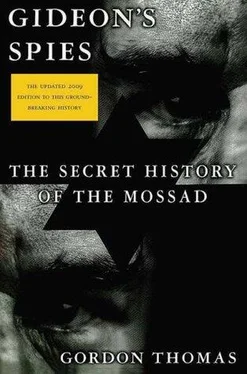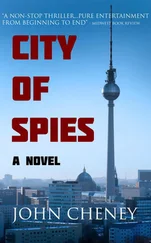Gordon Thomas - Gideon's Spies
Здесь есть возможность читать онлайн «Gordon Thomas - Gideon's Spies» весь текст электронной книги совершенно бесплатно (целиком полную версию без сокращений). В некоторых случаях можно слушать аудио, скачать через торрент в формате fb2 и присутствует краткое содержание. Город: New York, Год выпуска: 2009, ISBN: 2009, Издательство: Thomas Dunne Books, Жанр: История, на английском языке. Описание произведения, (предисловие) а так же отзывы посетителей доступны на портале библиотеки ЛибКат.
- Название:Gideon's Spies
- Автор:
- Издательство:Thomas Dunne Books
- Жанр:
- Год:2009
- Город:New York
- ISBN:978-0-312-53901-6
- Рейтинг книги:4 / 5. Голосов: 1
-
Избранное:Добавить в избранное
- Отзывы:
-
Ваша оценка:
- 80
- 1
- 2
- 3
- 4
- 5
Gideon's Spies: краткое содержание, описание и аннотация
Предлагаем к чтению аннотацию, описание, краткое содержание или предисловие (зависит от того, что написал сам автор книги «Gideon's Spies»). Если вы не нашли необходимую информацию о книге — напишите в комментариях, мы постараемся отыскать её.
Gideon’s Spies
Gideon's Spies — читать онлайн бесплатно полную книгу (весь текст) целиком
Ниже представлен текст книги, разбитый по страницам. Система сохранения места последней прочитанной страницы, позволяет с удобством читать онлайн бесплатно книгу «Gideon's Spies», без необходимости каждый раз заново искать на чём Вы остановились. Поставьте закладку, и сможете в любой момент перейти на страницу, на которой закончили чтение.
Интервал:
Закладка:
They arrived in Mexico City on November 28. Waiting at the airport was a man who would never be identified. The three of them traveled on to Uruapan, arriving there in the afternoon. Nir then chartered a T 210 Cessna from the small Aerotaxis de Uruapan.
Once more Nir behaved with strange inconsistency. He rented the aircraft in the name of “Patrick Weber,” using a credit card in that name to pay the charges, and arranged with a pilot to fly them to the Nucal processing plant in two days’ time. In the local hotel where they shared a room, Nir registered under his own name. The man who had accompanied them from Mexico disappeared as mysteriously as he had appeared.
On November 30, Nir and Stanton turned up at the small Uruapan airport, this time with another man. On the passenger manifest he was listed as Pedro Espionoza Huntado. Whom he worked for would remain yet another mystery. Another would be why, when they came to enter their own names on the manifest, both Nir and Stanton used their real identities. If the pilot noticed the discrepancy between the name Nir had given to charter the Cessna, it passed without comment.
The plane took off in good flying conditions. On board were the pilot, a copilot, and their three passengers. One hundred miles into the flight, the Cessna suddenly developed engine trouble and moments later crashed, killing Nir and the pilot. Stanton was seriously injured, the copilot and Huntado less so. By the time the first rescuer, Pedro Cruchet, arrived on the scene, Huntado had disappeared—another of those figures never to be seen again. How exactly Cruchet came to be first on the scene was yet another twist. He claimed to work for Nucal—but the company’s plant was a considerable distance away. He could not explain why he had been so close to the crash site. Asked by police to prove his identity, he pleaded he had lost his ID at a bullfight. It turned out Cruchet was an Argentinian living in Mexico illegally. By the time that had been established he, too, had vanished. At the crash site, Cruchet had recovered and identified Nir’s body, and he had accompanied Stanton to the hospital. He was with her when a local reporter called seeking further details.
Joel Bainerman, the publisher of the Israeli political intelligence digest, would claim: “A young woman indicated Cruchet was present. When she went to get him, another woman appeared at the door and told the journalist that Cruchet wasn’t there and that she had never heard of him. The second woman reiterated that Stanton’s presence on the Cessna was purely a coincidence and that she had no connection with ‘the Israeli.’ She refused to identify herself other than to say she was in Mexico as a tourist from Argentina.”
Stanton added to the mystery. She told crash investigators, according to Israeli journalist Ran Edelist in 1997: “While injured and shocked, she saw Amiram Nir a few meters away, waving and comforting her in a normal voice. ‘Everything will be okay. Help is on the way!’ She was twice assured in the days following that Nir was alive.”
Nir’s body was flown back to Israel for burial. Over one thousand mourners attended his funeral and, in his eulogy, Defense Minister Yitzhak Rabin spoke of Nir’s “mission to as-yet-unrevealed destinations on secret assignments and of secrets which he kept locked in his heart.”
Had Amiram Nir been murdered to make sure he never revealed those secrets? Was it even Nir’s body in the coffin? Or had he been killed before the crash? And if so, by whom? In Tel Aviv and Washington, a blanket of silence continues to greet all such questions.
Two days after the crash, Ari Ben-Menashe emerged from a post office in downtown Santiago, Chile. He was accompanied by two of the bodyguards he now felt it important to have to protect him. Suddenly:
“The window I was walking past shattered. Then something smashed into the metal custom-built briefcase I was carrying. The two bodyguards and I dived to the floor, realizing someone was shooting at us.”
Stanton was the next to believe her life was in danger. According to Edelist, his intelligence contacts had told him she “became a recluse, underwent plastic surgery, and changed her appearance.”
Increasingly, Mossad believed the CIA had murdered Nir. According to Ari Ben-Menashe, “Israeli intelligence has always believed it was a well-executed CIA operation. Nir’s death ensured there would be no embarrassment for Reagan and Bush at the trial of Oliver North.”
Support for this theory came from a U.S. Navy commander who had accompanied Nir to Tehran on the fruiterer’s mission to free the Beirut hostages. The commander’s story revolved around his claim that Nir had met with George Bush, then vice president, on July 29, 1986, at the King David Hotel in Jerusalem, to brief him about the ongoing sale of U.S. arms via Israel to Iran. According to the writer Joel Bainerman, “Nir was secretly taping the entire conversation. And this provided him with evidence linking Bush to the arms-for-hostages deal. At the meeting were McKee and Gannon, who would die in the Pan Am flight over Lockerbie.”
Bainerman would describe a visit the commander had made to CIA headquarters in Langley where he had met Oliver North some months before the colonel faced trial. In the writer’s words, the commander asked North “what had happened to Nir. North told him that Nir was killed because he threatened to go public with the recording of the Jerusalem meeting.”
Journalists who have tried to question North on the matter have been brushed aside. Bush’s aides have over the years maintained a similar attitude: anything the former president of the United States has to say on Irangate has already been stated.
In late July 1991, the home of Nir’s widow, Judy, was burgled. His recordings and documents were the only items stolen. Police said the break-in was “highly professional.” Judy Nir said she was certain the stolen material contained “information that would attack certain people.” She refused to be drawn beyond that. The material has never been recovered. The question of who stole it has remained unanswered.
For the next four years, Shabtai Shavit continued to run Mossad, making every effort to keep it out of the headlines and free of the attention of the mythmakers as it continued to pursue its information gathering.
Away from the public gaze, the old jockeying for power within the Israeli intelligence community had lost none of its energy. Politicians who still sat on the oversight subcommittee on intelligence remembered how Shavit had bested them after the Gulf War. Memories are as long in Israel as anywhere else, and the whispering campaign against Shavit had continued: his focus was too narrow; the back channel to the CIA was barely ajar; he wasn’t good at delegating; he was too aloof from the rank and file, among whom morale was falling.
Shabtai Shavit chose to ignore the warning signs. Suddenly, on a pleasant spring morning in 1996, he was summoned to the office of Prime Minister Benyamin Netanyahu and told he was being replaced. Shavit made no attempt to argue; he had seen enough of Netanyahu to know that would be pointless. He had only asked one question: Who was his successor?
Netanyahu had replied: Danny Yatom. The day of the Prussian had arrived for Mossad.
CHAPTER 17
BUNGLEGATE
Dawn was breaking on Thursday, January 16, 1998, when the government car pulled away from the white-painted house in an exclusive suburb close to the electrified fence marking the border between Israel and Jordan. In one of those twists of history that abound in Israel, the house stood on grounds where the spies of Gideon, the great Jewish warrior, had prepared their intelligence-gathering missions to enable the Israelis to defeat overwhelmingly superior forces. Now, Danny Yatom was setting off to finalize an operation that could save his career.
Читать дальшеИнтервал:
Закладка:
Похожие книги на «Gideon's Spies»
Представляем Вашему вниманию похожие книги на «Gideon's Spies» списком для выбора. Мы отобрали схожую по названию и смыслу литературу в надежде предоставить читателям больше вариантов отыскать новые, интересные, ещё непрочитанные произведения.
Обсуждение, отзывы о книге «Gideon's Spies» и просто собственные мнения читателей. Оставьте ваши комментарии, напишите, что Вы думаете о произведении, его смысле или главных героях. Укажите что конкретно понравилось, а что нет, и почему Вы так считаете.












